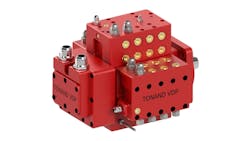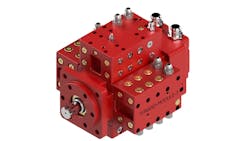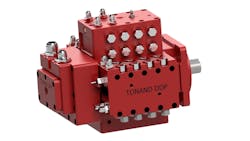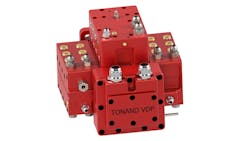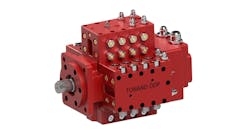A New Approach to Variable Displacement Piston Pump Design
What you’ll learn:
- The industry drivers prompting the need for new hydraulic pump designs.
- How digital control is employed and the benefits it provides.
- The design features enabling quieter and more efficient piston pump operation.
Demand for quieter and more efficient hydraulic components is increasing due in large part to the electrification of construction, agricultural and other mobile machinery. Recognizing that a major shift was taking place in the industry, Tonand Pumps set out to develop a hydraulic pump capable of meeting these design requirements.
After almost a decade of development, the company has created a variable displacement piston pump which is extremely quiet.
“We wanted a pump that is distinctive and quiet as a mouse, which goes hand in hand with electrification,” said Tony Cannata, Vice President and CTO, Tonand Pumps.
With the removal of internal combustion engines in many electric vehicles, operating noise from hydraulics and other components has become a greater concern. By developing a hydraulic pump capable of quieter operation, fewer noise mitigation materials are required. This helps to ease design and installation as well as save on space which is often at a premium in electric machines due to the size and number of batteries required.
The variable displacement piston pump offers additional benefits as well. Cannata said the company focused on developing a hydraulic pump that was totally different from what is currently in the market to help meet the electrification, digitalization and other major industry trends influencing machine and component designs.
Creation of a Quieter and More Efficient Hydraulic Piston Pump
According to Cannata, removal of the wobble plate from the variable displacement piston pump design is a key factor enabling it to operate at extremely low decibels.
He said the pump essentially runs at a conversational level of decibels. He noted that one OEM commented to the company when it saw the piston pump “you literally have to put your ear on the pump to be able to hear it.”
Removal of the wobble plate also allowed for the creation of a displacement on demand feature. To achieve this, the pump has an inner piston and an outer piston each with its own bore. “The outer piston has its own inlet and outlet bore, and the inner piston is in communication with a totally different bore, so there is no sharing of bores,” explained Cannata.
Essentially, he said it is a piston inside of a piston, and it is possible to have multiple pistons if desired. “We're basically able to provide anywhere from 40-50 different displacement combinations [which is] dictated by the number of pistons and bores.”
With this design, different flows can be achieved. “We simply disconnect one of the groups, whether that be the inner group of pistons or the outer group of pistons,” he explained. “And everything is digitally controlled.”
Engagement and disengagement of the pistons is virtually impossible to hear, he noted. There is no impact sound, such as a large thump, that can be heard when changing flows as might be the case with other pump designs because of the quiet and smooth transition between the pistons and actuators, said Cannata.
These and other design features help to create a more efficient variable displacement piston pump as well. An energy recovery system (ERS) is integrated into the pump which recovers kinetic energy that is then used to drive a small turbine on the main shaft of the pump. The turbine helps create shaft rotation to reduce energy drawn from the prime mover of the machine.
Further energy recovery is built into the pump’s case drain. Typically, a case drain is built into piston pumps to provide internal leakage which helps keep components lubricated to minimize wear and tear. However, there is also wasted energy associated with case drains that can reduce overall pump efficiency.
To overcome this issue, Cannata said Tonand Pumps spent years perfecting its case drain design so it would instead recoup energy that would otherwise be lost. It does so by having an optimized internal mechanism that eliminates potential leak points except for those essential to piston blow-by. The energy that would otherwise be wasted can now instead be used for outlet flow or auxiliary functions such as powering cooling fans.
Hydraulic Pump Digitalization Benefits Maintenance and Performance
Incorporation of electronics into the variable displacement piston pump creates a digital framework for the pump to enable better control and monitoring capabilities.
Cannata said 24V solenoids are utilized to control the pump’s variable output. This allows dynamic displacement adjustment by digitally selecting which piston groups are active. The pump is composed of multiple independently operable displacement groups that can be controlled in this manner to help provide efficient and adjustable performance to meet specific application requirements. He noted that the pump’s smallest piston group can deliver 1.5 GPM at 3,000 psi using just over 2 hp.
Meanwhile, sensors are integrated into the pump to help monitor performance aspects such as temperature and pressure for improved maintenance.
Equipping the pump with sensors makes it easier to determine when there may be a performance issue that needs to be addressed. The sensors communicate with the monitoring systems that are now included on most mobile machinery; if the sensors detect operating pressures or temperatures are not what they should be, an alert can be sent to operators so they can take action to fix the issue and minimize unplanned downtime.
“One of the features with our pump is the ability that one has to monitor each and every bore live, so that if there is a pending issue [a warning is sent],” said Cannata. This monitoring makes it possible to pinpoint which cylinder on the pump may be faulty — making it easier to quickly address. With this capability, it is also possible to replace just the faulty cylinder instead of the entire pump, further easing maintenance and reducing costs.
He also noted that due to the pump’s design, if there is an issue with one cylinder the rest of the pump will continue to work. “Rather than shut down for the day or the week so that you can get the pump fixed, you can literally get the faulty module removed in a matter of minutes…and continue to work,” he explained. The pump will operate at a lower displacement volume, but the time and cost associated with unplanned downtime can be minimized.
Digital Control Eliminates Need for External Intensifier System
Use of digital control allowed Tonand Pumps to add an integrated hydraulic pressure intensifier system to the pump. While the company did not set out to include this technology when it began developing its variable displacement piston pump, its inclusion “emerged naturally from our core innovation — a digitally controlled, modular piston pump,” said Cannata.
He explained that traditional hydraulic systems rely on external intensifiers to achieve high pressure where standard pumps would stall or become inefficient. This can increase cost, complexity and the footprint of the system.
But these can be eliminated with Tonand’s pump because the intensifier functionality is built into the pump itself. “Each displacement group within the pump is independently controllable. For high-pressure, low-flow demands — such as clamping or forming — only the smallest group is activated,” he said. “This delivers focused flow at high pressure, without the need for external intensification.”
By eliminating the need for an external intensifier, several benefits can be achieved including:
- no external hardware or switching valves required
- faster response and improved efficiency
- lower component count and reduced maintenance
- quiet operation across pressure ranges
- smooth transitions between flow/pressure modes.
A Hydraulic Pump to Meet Various Mobile Equipment Requirements
Tonand Pumps envisions its variable displacement piston pump suiting the needs of various mobile machinery requiring displacements up to 20 GPM, whether equipped with a diesel engine, batteries or other power source.
While Cannata sees the pump meeting the needs of a good portion of the market due to its ability to operate at different flow rates, if displacements of over 20 GPM are required it could be possible to create a larger displacement version using the same frame size. However, it will be necessary to assure other componentry, such as valves, can handle the increased flow provided by the pump.
The company continues to develop and test the pump for any additional features it could add. “We continue to do testing [and] see improvements, we continue keeping an eye on the industry and see where it's going,” to ensure the pump will meet industry needs he said.
Cannata said the company is also speaking with various original equipment manufacturers (OEM) about the potential of licensing the pump technology. He said Tonand Pumps is not interested in reinventing the wheel, so to speak. “There’s people out there that have been designing and building pumps for a long time,” he said. “They've got the tools, they've got the facilities, they've got the distribution channels…so our goal is to ideally issue a licensing agreement to a current manufacturer.”
A joint venture or other options would be considered as well. In general, the company’s desire is to help bring this hydraulic technology to the market to meet increasing requirements for quiet, efficient and digitally controlled solutions.
About the Author
Sara Jensen
Executive Editor, Power & Motion
Sara Jensen is executive editor of Power & Motion, directing expanded coverage into the modern fluid power space, as well as mechatronic and smart technologies. She has over 15 years of publishing experience. Prior to Power & Motion she spent 11 years with a trade publication for engineers of heavy-duty equipment, the last 3 of which were as the editor and brand lead. Over the course of her time in the B2B industry, Sara has gained an extensive knowledge of various heavy-duty equipment industries — including construction, agriculture, mining and on-road trucks —along with the systems and market trends which impact them such as fluid power and electronic motion control technologies.
You can follow Sara and Power & Motion via the following social media handles:
X (formerly Twitter): @TechnlgyEditor and @PowerMotionTech
LinkedIn: @SaraJensen and @Power&Motion
Facebook: @PowerMotionTech

Leaders relevant to this article:
